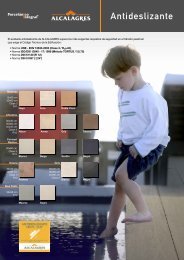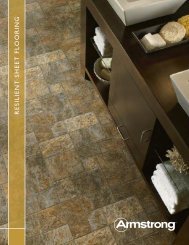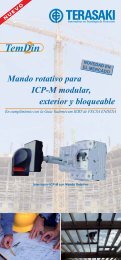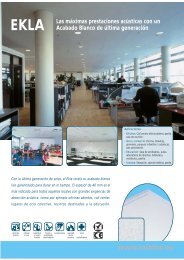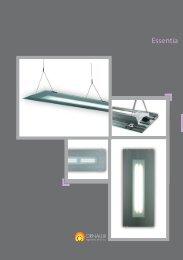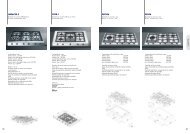manual de colocación de baldosas cerámicas - Habitissimo
manual de colocación de baldosas cerámicas - Habitissimo
manual de colocación de baldosas cerámicas - Habitissimo
You also want an ePaper? Increase the reach of your titles
YUMPU automatically turns print PDFs into web optimized ePapers that Google loves.
05. JUNTAS DE DEFORMACIÓN<br />
También llamadas juntas <strong>de</strong> movimiento, son discontinuida<strong>de</strong>s<br />
diseñadas y ejecutadas sobre un recubrimiento cerámico, que<br />
tienen por objeto absorber las posibles variaciones<br />
dimensionales que se produzcan en el sistema multicapa<br />
compuesto por el soporte, material <strong>de</strong> agarre y producto<br />
cerámico.<br />
CLASIFICACIÓN:<br />
> Estructurales<br />
Deben coincidir con las <strong>de</strong> la estructura soporte y tener una<br />
anchura comprendida entre 1 y 3 cm. Tienen que haber sido<br />
<strong>de</strong>talladas previamente en el proyecto <strong>de</strong> edificación por<br />
un técnico competente.<br />
Junta <strong>de</strong><br />
Colocación<br />
> Perimetrales<br />
Presentes en el encuentro <strong>de</strong> un pavimento con un tabique,<br />
pilar, ventanal o cualquier elemento constructivo que se apoye<br />
sobre dicho pavimento. Suele ser <strong>de</strong> 4 ó 5 mm y queda oculta<br />
por el rodapié. Resulta imprescindible que alcancen en<br />
profundidad el soporte o capa <strong>de</strong> separación si la hubiere.<br />
Junta<br />
Perimetral Baldosas<br />
> De dilatación o retracción<br />
Junta<br />
Estructural Baldosas<br />
Junta <strong>de</strong><br />
Dilación Baldosas<br />
Junta <strong>de</strong><br />
Colocación<br />
Material <strong>de</strong><br />
Agarre<br />
Nivelación<br />
Soporte<br />
Material <strong>de</strong><br />
Agarre<br />
Nivelación<br />
Soporte<br />
Permiten las <strong>de</strong>formaciones originadas por efectos térmicos<br />
e higroscópicos entre <strong>baldosas</strong>, adhesivo y soporte. Su<br />
disposición pue<strong>de</strong> efectuarse a pie <strong>de</strong> obra teniendo en cuenta<br />
los siguientes criterios:<br />
- Anchura mínima <strong>de</strong> 5 mm.<br />
- Deben colocarse interrumpiendo dimensiones lineales que<br />
sobrepasen los 6 m o áreas <strong>de</strong> 30 m.<br />
- Deben ser flexibles, impermeables y estar bien adheridas,<br />
atravesando incluso el material <strong>de</strong> agarre.<br />
Material <strong>de</strong><br />
Agarre<br />
Nivelación<br />
Soporte<br />
05. EXPANSION JOINTS<br />
These joints, also known as movement joints, are gaps <strong>de</strong>liberately<br />
left between laid tiles. Their purpose is to absorb any possible<br />
changes in dimensions that may occur in the system consisting<br />
of the support, the bonding material and the tile.<br />
CLASSIFICATION:<br />
> Structural<br />
These must coinci<strong>de</strong> with those of the supporting structure and<br />
must be between 1 and 3 cm wi<strong>de</strong>. They must have been<br />
<strong>de</strong>tailed at an earlier stage in the building <strong>de</strong>sign by a<br />
competent expert.<br />
Laying joint<br />
> Perimeter<br />
These are found at the point where a floor meets a partition<br />
wall, pillar, large window or other construction element that<br />
stands on the floor. They usually measure 4 or 5 mm and are<br />
hid<strong>de</strong>n by the skirting. It is essential that they extend down<br />
to the support or separation layer if any.<br />
> Dilation or shrinkage<br />
Structural<br />
joint Tiles<br />
Perimeter<br />
joint Tiles Laying joint<br />
Dilation<br />
joint Tile<br />
Bonding<br />
material<br />
Levelling<br />
Base<br />
Bonding<br />
material<br />
Levelling<br />
Base<br />
These allow for any warping that may occur between the tile,<br />
adhesive and support due to thermal or hygroscopic effects.<br />
They can be ma<strong>de</strong> on site bearing in mind the following criteria:<br />
- Minimum width of 5 mm.<br />
- They must be placed in such a way that they create gaps to<br />
ensure that there are no unbroken lengths of over 6 m or<br />
solid surface areas of more than 30 m2.<br />
- They must be flexible, impermeable and properly adhered,<br />
and must also cross through the bonding material.<br />
Bonding<br />
material<br />
Levelling<br />
Base<br />
13




